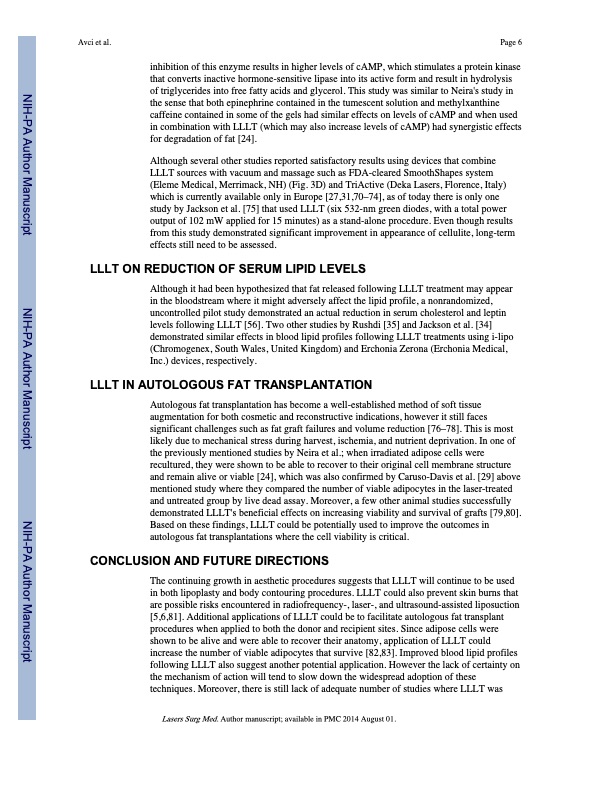
PDF Publication Title:
Text from PDF Page: 006
Avci et al. Page 6 inhibition of this enzyme results in higher levels of cAMP, which stimulates a protein kinase that converts inactive hormone-sensitive lipase into its active form and result in hydrolysis of triglycerides into free fatty acids and glycerol. This study was similar to Neira's study in the sense that both epinephrine contained in the tumescent solution and methylxanthine caffeine contained in some of the gels had similar effects on levels of cAMP and when used in combination with LLLT (which may also increase levels of cAMP) had synergistic effects for degradation of fat [24]. Although several other studies reported satisfactory results using devices that combine LLLT sources with vacuum and massage such as FDA-cleared SmoothShapes system (Eleme Medical, Merrimack, NH) (Fig. 3D) and TriActive (Deka Lasers, Florence, Italy) which is currently available only in Europe [27,31,70–74], as of today there is only one study by Jackson et al. [75] that used LLLT (six 532-nm green diodes, with a total power output of 102 mW applied for 15 minutes) as a stand-alone procedure. Even though results from this study demonstrated significant improvement in appearance of cellulite, long-term effects still need to be assessed. LLLT ON REDUCTION OF SERUM LIPID LEVELS Although it had been hypothesized that fat released following LLLT treatment may appear in the bloodstream where it might adversely affect the lipid profile, a nonrandomized, uncontrolled pilot study demonstrated an actual reduction in serum cholesterol and leptin levels following LLLT [56]. Two other studies by Rushdi [35] and Jackson et al. [34] demonstrated similar effects in blood lipid profiles following LLLT treatments using i-lipo (Chromogenex, South Wales, United Kingdom) and Erchonia Zerona (Erchonia Medical, Inc.) devices, respectively. LLLT IN AUTOLOGOUS FAT TRANSPLANTATION Autologous fat transplantation has become a well-established method of soft tissue augmentation for both cosmetic and reconstructive indications, however it still faces significant challenges such as fat graft failures and volume reduction [76–78]. This is most likely due to mechanical stress during harvest, ischemia, and nutrient deprivation. In one of the previously mentioned studies by Neira et al.; when irradiated adipose cells were recultured, they were shown to be able to recover to their original cell membrane structure and remain alive or viable [24], which was also confirmed by Caruso-Davis et al. [29] above mentioned study where they compared the number of viable adipocytes in the laser-treated and untreated group by live dead assay. Moreover, a few other animal studies successfully demonstrated LLLT's beneficial effects on increasing viability and survival of grafts [79,80]. Based on these findings, LLLT could be potentially used to improve the outcomes in autologous fat transplantations where the cell viability is critical. CONCLUSION AND FUTURE DIRECTIONS The continuing growth in aesthetic procedures suggests that LLLT will continue to be used in both lipoplasty and body contouring procedures. LLLT could also prevent skin burns that are possible risks encountered in radiofrequency-, laser-, and ultrasound-assisted liposuction [5,6,81]. Additional applications of LLLT could be to facilitate autologous fat transplant procedures when applied to both the donor and recipient sites. Since adipose cells were shown to be alive and were able to recover their anatomy, application of LLLT could increase the number of viable adipocytes that survive [82,83]. Improved blood lipid profiles following LLLT also suggest another potential application. However the lack of certainty on the mechanism of action will tend to slow down the widespread adoption of these techniques. Moreover, there is still lack of adequate number of studies where LLLT was Lasers Surg Med. Author manuscript; available in PMC 2014 August 01. NIH-PA Author Manuscript NIH-PA Author Manuscript NIH-PA Author ManuscriptPDF Image | Low-Level Laser Therapy for Fat Layer Reduction

PDF Search Title:
Low-Level Laser Therapy for Fat Layer ReductionOriginal File Name Searched:
nihms-509305.pdfDIY PDF Search: Google It | Yahoo | Bing
Cruise Ship Reviews | Luxury Resort | Jet | Yacht | and Travel Tech More Info
Cruising Review Topics and Articles More Info
Software based on Filemaker for the travel industry More Info
The Burgenstock Resort: Reviews on CruisingReview website... More Info
Resort Reviews: World Class resorts... More Info
The Riffelalp Resort: Reviews on CruisingReview website... More Info
| CONTACT TEL: 608-238-6001 Email: greg@cruisingreview.com | RSS | AMP |